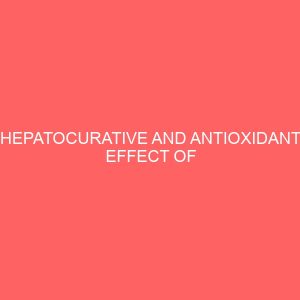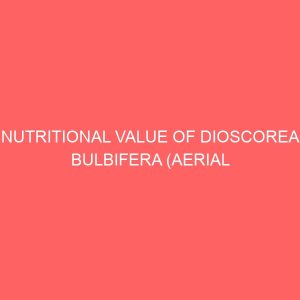Description
CHAPTER ONE
INTRODUCTION
1.1 Preamble
This research is on Hepatocurative and antioxidant effect of ethyl-acetate and n-butanol fractions of detarium microcarpum stem bark in ccl4 induced liver damage in wistar rats. Herbal medicines are herbal preparations produced by subjecting plant materials to extraction, fractionation, purification, concentration or other physical or biological processes which may be produced for immediate consumption or as a basis for herbal products (WHO, 2001). Notwithstanding the extent of significant advancement in modern medicine in recent decades, plants still make an important contribution to health care. Traditionally they are used worldwide for the prevention and treatment of disease. Herbal plants were prescribed even when their active compounds were unknown because of their effectiveness and relatively low cost (Bhawna and Kumar, 2010). This observation is particularly more relevant to people in the developing countries of the world where the majority of the populations are living in the rural areas.
The liver plays an important role in regulating various physiological processes. It is essential in the body for maintenance, performance and regulating homeostatic functions. It is involved with almost all the biochemical pathways for growth, fight against diseases, nutrient supply, energy provision and reproduction. In addition, it aids metabolism of carbohydrate, protein and fat, detoxification, secretion of bile and storage of vitamins (Ahsan et al., 2009). Because of its central role in drug metabolism, it is the most vulnerable tissue for drug toxicity (Sunil et al., 2012). The role played by the liver in the removal of substances from the portal circulation makes it susceptible to persistent attack by offending foreign compounds, culminating in liver dysfunction (Bodakhe and Ram, 2007). The liver secretes bile, prothrombin, fibrinogen, blood-clotting factors and heparin, a mucopolysaccharide sulfuric acid ester that prevents blood from clotting within the circulatory system (Bhawna and Kumar, 2010). Toxic chemicals, xenobiotics, alcohol consumption, malnutrition, anaemia, medications, autoimmune disorders (Marina, 2006), viral infections (hepatitis A, B, C, D, etc.) and microbial infections (Sharma and Ahuja, 1997) are harmful and cause damage to the hepatocytes.
Reactive oxygen species (ROS) are continuously generated during metabolic processes to regulate a number of physiological functions essential to the body (Valko et al., 2007). These reactive oxygen species are prone to withdraw electrons from biological macromolecules such as proteins, lipids, nucleic acids in order to gain stability in the biological system. This disruption may be attributed to a number of factors such as the inability of the cells to produce sufficient amounts of antioxidants, nutritional deficiency of minerals or vitamins (Abd Ellah, 2010). When the production of ROS exceeds the capability of the body to detoxify these reactive intermediates, oxidative stress would develop (Mena et al., 2009). Oxidative stress can be induced by variety of factors such as radiation or exposure to heavy metals and xenobiotics (e.g carbon tetrachloride). This may lead to drastic harm to the body such as membrane damage, mutations due to attenuation of DNA molecules, and disruption to various enzymatic activities in metabolism of the body (McGrath et al., 2001; Valko et al., 2006; Chanda and Dave, 2009).
Medicinal plants are important sources of antioxidants (Rice, 2004). Antioxidants stabilize or deactivate free radicals, often before they attack targets in biological cells (Nunes et al., 2012). Natural antioxidants either in the form of raw extracts or their chemical constituents are very effective in preventing the destructive processes caused by oxidative stress (Zengin et al., 2011). Recently interest in naturally occurring antioxidants has considerably increased for use in food, cosmetic and pharmaceutical products, because they are multifaceted in their multitude and magnitude of activity and provide enormous scope in correcting imbalance (Djeridane et al., 2006; Wannes et al., 2010). The beneficial medicinal effects of plant materials typically results from the combinations of secondary products present in the plant (Wink, 1999). Phytochemical constituents of medicinal plants (e.g. polyphenols, carotenoids, flavonoids, phenolics, vitamins C and E), act as antioxidants by preventing damages to cell membrane due to cellular oxidative processes that may result in diseases (Omoregie and Osagie, 2011). They are found in all parts of plants such as leaves, fruits, seeds, roots and bark (Mathew and Abraham, 2006).
Antioxidants are broadly divided into enzymic antioxidants and non enzymic antioxidants. Enzymic antioxidants include the superoxide dismutases, glutathione peroxidase and catalase (Klaunig and Kamendulis, 2004). Non-enzymic antioxidants, which include vitamin E, vitamin C, ?-carotene, reduced glutathione, and coenzyme Q function to quench reactive oxygen species (Clarkson and Thompson, 2000). Antioxidants have various mechanisms such as prevention of chain initiation, binding of transition metal ion catalysts, decomposition of peroxides, prevention of continued hydrogen abstraction and radical scavenging (Rao et al., 2004). Many chemicals damage mitochondria, an intracellular organelle that produces energy, its dysfunction release excessive amount of oxidants which in turn damage hepatic cells. Activation of some enzymes in the cytochrome P450 system, such as CYP2E1, also leads to oxidative stress (Jaeschke et al., 2002).
Carbon tetrachloride (CCl4) is a well known hepatotoxin used in diverse experimental models (Singh et al., 2008). In addition to hepatic problems, it causes dysfunction of the kidneys, lungs, testis, brain, and blood by generating free radicals (Ozturk et al., 2003; Khan et al., 2009). Carbon tetrachloride (CCl4) is rapidly transformed to trichloromethyl radical (CCl3*) and its derivative trichloromethyl peroxy radical (CCl3OO*), generated by cytochrome P450 of liver microsomes (Brent and Rumack, 1993). These free radicals react with membrane lipids leading to their peroxidation (Singh et al., 2008). Membrane disintegration of hepatocytes with subsequent release of membrane associated enzymes and necrosis are some of the consequences of CCl4 induced liver damage.
1.2 Statement of Research Problem
Hepatotoxicity is one of the very common ailments resulting into serious debilities ranging from severe metabolic disorders to even mortality (Anil et al., 2010). Liver injury due to chemicals or infectious agents may lead to progressive liver fibrosis and ultimately cirrhosis and liver failure (Anand, 1999). According to the report published by USFDA, more than 900 drugs, toxins, and herbs have been reported to cause liver injury, and drugs account for 20 40% of all instances of hepatic failure (Soni et al., 2011).
Liver ailments represent a major global health problem. Chronic liver cirrhosis and drug induced liver injury is the ninth leading cause of deaths in western and developing countries (Baranisrinivasan et al., 2009; Saleem et al., 2010).
In Nigeria, as in other parts of sub-saharan Africa, the major causes of liver cirrhosis include infections particularly chronic hepatitis B virus (HBV) infection (Otu, 1987 and Cook, 1980) and hepatitis C virus infection (Bojuwoye, 1996). There is increasing evidence that free radicals and reactive oxygen species play a crucial role in various steps that initiate and regulate the progression of liver diseases independently of the original agent (Jemal et al., 2007).
1.3 Justification
Liver diseases remain one of the major threat to public health and a worldwide problem (Asha and Pushpangdan, 1998). The use of medicinal plants with high level of antioxidant constituents has been proposed as an effective therapeutic approach for hepatic damages (Govind, 2011).
Many antioxidants have been used to protect organs from the free radical challenges. Several researches are attempting to explore the possibility of using herbs containing antioxidants as organ curative agents. In view of severe undesirable side effects of synthetic agents, there is a growing focus to follow systematic research methodology and to evaluate scientific basis for the traditional herbal medicines that are claimed to possess hepatocurative activity.
Though the stem bark of Detarium microcarpum is used traditionally in Nigeria as a valuable remedy to treat liver diseases, no detailed pharmacological investigation have been done to that respect. This is why the present study is being undertaken to investigate it?s hepatocurative and antioxidant activity.
1.4 AIM AND OBJECTIVES
1.4.1 Aim
The aim of this study is to investigate the hepatocurative and antioxidant effect of ethylacetate and n-butanol fractions of Detarium microcarpum stem bark in CCl4-induced liver damage in rats.
1.4.2 Specific objectives
i. To identify and quantify levels of some phytochemicals present in the crude extract, ethyl-acetate and n-butanol fractions of Detarium microcarpum stem bark.
ii. To carry out in-vitro antioxidant activity (such as DPPH, reducing power and H202 radical scavenging activity) on ethyl-acetate and n-butanol fractions of Detarium microcarpum stem bark and determine the lethal dose (LD50) of the fraction with the highest activity.
iii. To determine the effects of the fraction with the highest activity on some biochemical parameters (such as ALT, AST, ALP, Bilirubin, Total protein, Albumin, Urea and Creatinine) in CCl4 induced liver damage in rats.
iv. To determine the effect of the fraction with highest activity on some endogenous antioxidant enzyme levels and lipid peroxidation in the tissues of the animals induced with CCl4.
1.5 Null Hypothesis
Ethyl-acetate and n-butanol fractions of Detarium microcarpum stem bark do not have any hepatocurative and antioxidant effect on CCl4 induced liver damage in rats.







